King Solomon's Takanah: Rambam's Eruv - Hakirah.org
King Solomon's Takanah: Rambam's Eruv - Hakirah.org
King Solomon's Takanah: Rambam's Eruv - Hakirah.org
Create successful ePaper yourself
Turn your PDF publications into a flip-book with our unique Google optimized e-Paper software.
<strong>King</strong> Solomon’s <strong>Takanah</strong>: Rambam’s <strong>Eruv</strong> : 207<br />
The Chazon Ish (<strong>Eruv</strong>in 107:2) asks, how is it possible that<br />
Rav Yehudah can say רבים ומבטלי מחיצתא when the concept of a<br />
is never disputed. His answer is that מבוי of a מתיר as the צורת הפתח<br />
the principle of אתי רבים does not apply when the area into which the<br />
traffic enters is a "י .רה But according to Rambam, since a צורת הפתח is<br />
a ,פתח the concept of אתי רבים is inapplicable to it, for it pertains to<br />
the destruction of a מחיצה and is not operable to traffic entering a<br />
לחי , a where מבו י It is especially irrelevant to the openings of a .פתח<br />
is made for traffic and no traffic numbers מבוי apply. A "פ<br />
are stipulated or relevant and traffic passing through its gateway will<br />
אתי רבי not invalidate it. The gemara does not discuss the concept of<br />
with regard to מב וי for its openings are designed for the passage of<br />
traffic. 64<br />
צוה<br />
ם<br />
צוה<br />
אתי<br />
צוה<br />
מרובה<br />
קורה, וצוה<br />
is made even according to ,צוה "פ is needed even with a על הפרוץ<br />
the Rabbanan. This would explain the stance of Rambam that although<br />
עומד can close a gap greater than ten amos, still each wall must be "פ a<br />
does "פ Once we are willing to consider the idea that a .מרובה על הפרוץ<br />
not have the ability to turn an unlimited opening into a פתח we have<br />
obviously conceded that a "פ is not a wall; we cannot therefore<br />
necessarily solve the problem of פרוץ מרובה with it, for a wall with so<br />
many openings is considered .נפרץ It is important to note, that the<br />
interpretation of Maggid Mishnah here that when a "פ acts on less than<br />
ten amos it turns that area into valid מחיצה as if it was ,עומד has no<br />
support in Rambam’s language and is untenable.<br />
64 Having established that a צורת הפתח is a פתח and not a ,מחיצה we can<br />
better understand the role it plays in the building of a succah. A valid<br />
succah consists of three .דפנות It is not מחיצות that are needed but a new<br />
criteria that Rambam constantly repeats, called .דפנות (See Hilchos Succah<br />
4:2–7.) Indeed, מחיצות are good for דפנות (see halachos 5, 10, 11, 16) and<br />
even halachic מחיצות of Shabbos are good for דפנות during Shabbos<br />
within Succos. However, Rambam’s need to explain this, shows that the<br />
.מחיצות is not that of halachic דפנות standard we are dealing with for<br />
Moreover, were the standards the same, these מחיצות would be good<br />
even after Shabbos. The main difference between דפנות and מחיצות is<br />
ד<br />
צוה<br />
that for פנות we require only a minimum size to make up a wall and the<br />
rest can be completed with entrances—פתחים (Hilchos Succah 4:12).<br />
There is no need to have עומד מרובה על הפרוץ as long as any openings<br />
qualify as .פתחים However, when we deal with ,דפנות the walls of a hut, a<br />
,פתח greater than ten amos cannot normally be accepted as a פרצה<br />
therefore such an opening remains a פרצה even if it has a צורת הפתח and
















